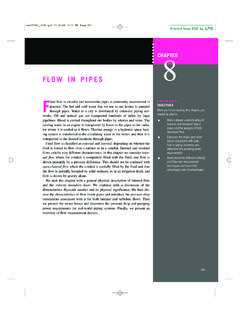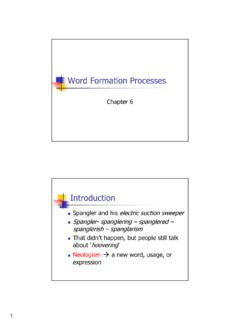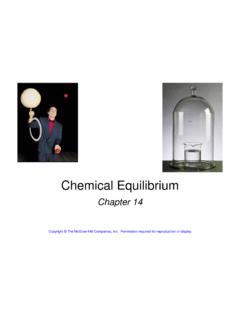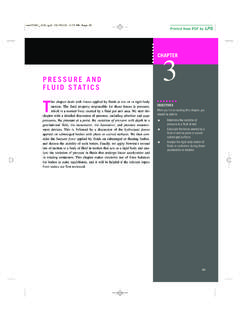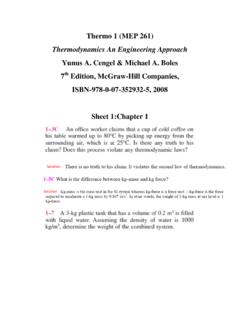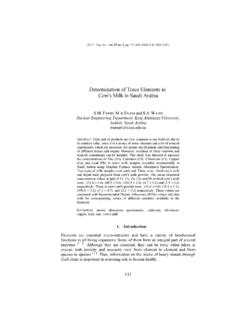Transcription of General Design Considerations - kau
1 1 General Design Considerations The development of a complete plant Design requires consideration of many different factors such as: a. Plant location b. Site and plant layout c. Plant operation and control d. Utilities e. Storage f. Waste disposal g. Health and safety h. Materials handling ( will be discussed in the next chapters) a- Plant Location and Site Selection The geographical location of the final plant can have strong influence on the success of an industrial venture. Considerable care must be exercised in selecting the plant site, and many different factors must be considered.
2 Primarily, the plant should be located where the minimum cost of production and distribution can be obtained, but other factors, such as room for expansion and safe living conditions for plant operation as well as the surrounding community, are also important. The major factors in the selection of most plant sites are: Marketing Area For materials that are produced in bulk quantities, such as cement, mineral acids, and fertilizers, where the cost of the product per metric ton is relatively low and the cost of transport is a significant fraction of the sales price, the plant should be located close to the primary market.
3 This consideration is much less important for low-volume production and high-priced products, such as pharmaceuticals. Raw Materials The availability and price of suitable raw materials will often determine the site location. Plants that produce bulk chemicals are best located close to the source of the major raw material, as long as the costs of shipping product are not greater than the cost of shipping feed. For example, at the time of writing much of the new ethylene capacity that is being added worldwide is being built in the Middle East, close to supplies of cheap ethane from natural gas.
4 Oil refineries, on the other hand, tend to be located close to major population centers, as an oil refinery produces many grades of fuel, which are expensive to ship separately. Transportation Facilities The transport of materials and products to and from the plant can be an overriding consideration in site selection. If practicable, a site should be selected that is close to at least two major forms of transport: road, rail, waterway (canal or river), or a sea port. Road transport is increasingly used and is suitable for local distribution from a central warehouse.
5 Rail transport is usually cheaper for the long-distance transport of bulk chemicals. Air transport is 2 convenient and efficient for the movement of personnel and essential equipment and supplies, and the proximity of the site to a major airport should be considered. Availability of Labors Labor will be needed for construction of the plant and its operation. Skilled construction workers are usually brought in from outside the site area, but there should be an adequate pool of unskilled labor available locally, and labor suitable for training to operate the plant. Skilled craft workers such as electricians, welders, and pipe fitters will be needed for plant maintenance.
6 Local labor laws, trade union customs, and restrictive practices must be considered when assessing the availability and suitability of the local labor for recruitment and training. Water supply Chemical processes invariably require large quantities of water for cooling, washing, steam generation, and as a raw material, and the plant must be located near a source of water of suitable quality. Process water may be drawn from a river, from wells, or purchased from a local authority. Energy Availability (power and fuel) Power and steam requirements are high in most industrial plants, and fuel is ordinarily required to supply these utilities.
7 Consequently, power and fuel can be combined as one major factor in the choice of a plant site. If the plant requires large quantities of coal or oil, location near a source of fuel supply may be essential for economic operation. The local cost of power can help determine whether power should be purchased or self-generated. Electrical power is needed at all sites. Electrochemical processes (for example, chlorine manufacture or aluminum smelting) require large quantities of power and must be located close to a cheap source of power.
8 A competitively priced fuel must be available on site for steam and power generation. Climate Adverse climatic conditions at a site will increase costs. Abnormally low temperatures require the provision of additional insulation and special heating for equipment and pipe runs. Stronger structures are needed at locations subject to high winds (cyclone/ hurricane areas) or earthquakes. Corrosive environments will need strong protection for the plant equipment. 3 b- Site layout and plant layout Site layout The process units and ancillary buildings should be laid out to give the most economical flow of materials and personnel around the site.
9 Hazardous processes must be located at a safe distance from other buildings. Consideration must also be given to the future expansion of the site. The ancillary buildings and services required on a site, in addition to the main processing units (buildings), include 1. Storage for raw materials and products: tank farms and warehouses; 2. Maintenance workshops; 3. Stores, for maintenance and operating supplies; 4. Laboratories for process quality control; 5. Fire stations and other emergency services; 6. Utilities; 7. Effluent disposal plant: waste water treatment, solid and or liquid waste collection; 8.
10 Offices for General administration; 9. Canteens and other amenity buildings, such as medical centers; 10. Parking lots. When the preliminary site layout is roughed out, the process units are normally sited first and arranged to give a smooth flow of materials through the various processing steps, from raw material to final product storage. Process units are normally spaced at least 30 m apart; greater spacing may be needed for hazardous processes. The location of the principal ancillary buildings should then be decided. They should be arranged so as to minimize the time spent by personnel in traveling between buildings.
